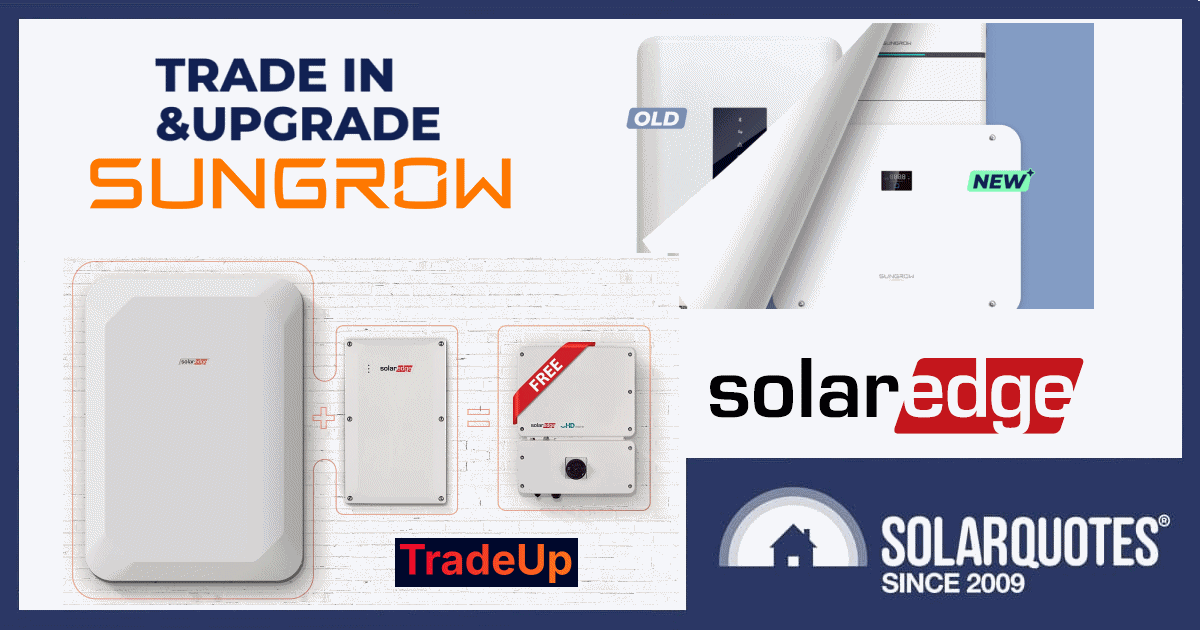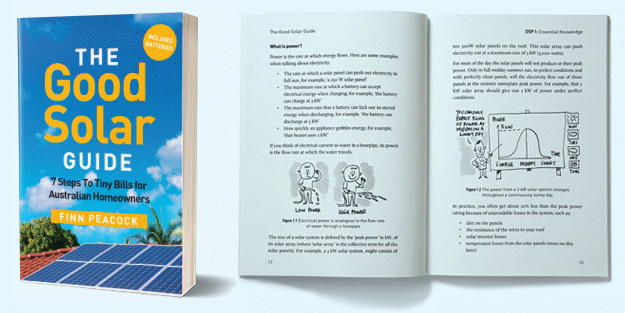Solar manufacturers Sungrow and SolarEdge are still offering inverter trade-in (or up) programs in Australia when upgrading their systems to new hybrid inverters and/or batteries from the respective firms. Here’s how the schemes work and what you can get.
Sungrow Inverter Trade-In Offer
Originally launched in late June 2025, Sungrow’s initiative enables Australian customers to swap their existing Sungrow inverters via the company’s certified installer network to receive rebates for upgrading to the firm’s latest-generation hybrid inverter and Sungrow battery systems.
Dozens of older Sungrow inverter models are eligible for the scheme, with trade-in values ranging from $500 for 2 kW inverters to $1,700 for some 20 kW units. The list includes the SG5K-D ($800 trade-in) and SG8K-D ( $1,000 trade-in), which have exceeded installations of 100,000 units each in Australia according to the firm.
Rebates are issued after the new system is installed, the trade-in units are returned and received, and all documents have been reviewed and approved by Sungrow. A Sungrow certified installer manages the entire trade-in process, from the submission of the application to the return of the trade-in and application of credit.
Currently a pilot program, Sungrow may make it a long-term initiative depending on results. Further details can be found here.
As at June 2025, 870 GW of Sungrow power electronic converters have been installed worldwide, and the company claims deployment of more than 400,000 residential systems in Australia.
“As one of the first company-led trade-in initiatives in Australia’s residential energy sector, the program helps establish a closed-loop model covering energy consumption, product use, recycling, and regeneration,” states the firm.
SolarEdge Inverter TradeUp Deal
SolarEdge’s TradeUp program has been around for quite a while. TradeUp is currently available when adding a single- or 3-phase SolarEdge Home Battery & Backup Interface to an existing SolarEdge single-phase or residential three-phase system.
Under the program, an existing eligible SolarEdge inverter can be traded-up to a new single- or three-phase 10 kW — or 5 kW if preferred — Home Hub Universal Inverter at no cost, which will come with a fresh 12-year inverter warranty.
Furthermore, an older SolarEdge residential 3-phase inverter can be replaced with two new single-phase inverters (Home Hub and Genesis) as part of the TradeUp program to meet inverter capacity phase imbalance requirements specified by Distributed Network Service Providers (DNSPs) in some states and regions.
How much longer TradeUp will be around for isn’t clear. Back in 2024, the company said it was available until December 31, 2025, or until 1,000 inverters had been exchanged; but that may have changed since.
In related news, late last month SolarEdge announced its Home Hub Universal 3-Phase 10kW Inverter and new stackable DC-coupled modular 3-phase battery are slated for Clean Energy Council (CEC) listing this month according to the firm, with shipments beginning mid-November.
Key features of Home Hub Universal 3-Phase 10kW Inverter:
- Model number: SE10K-RWB48
- 3-phase backup (with Backup Interface).
- Single string design < 13.3kW.
- 200% oversizing (with batteries).
- Connect up to 2 followers.
- Datasheet here
Key features of the Stackable Home Battery:
- Model number: BAT-05K48
- Stackable modular 4.85kWh battery (1-5 in parallel).
- Maximum capacity: 24.25kWh per Home Hub.
- Scalable up to 72.75kWh storage with 2x SE10K-RWB48 followers.
- DC Coupled, with AC-coupled capability.
- 3-phase backup (with Backup Interface).
- Datasheet here
Combined with the national solar battery rebate, there are significant savings to be had under both initiatives. The Cheaper Home Batteries program currently provides an up-front discount on the purchase and installation of eligible energy storage systems of roughly 30%.
These manufacturer programs are an interesting move on a couple of fronts — encouraging existing customers to stay within the brands’ component ecosystems, and (hopefully) responsible recycling/disposal of returned solar inverters.
Sungrow says:
“Once collected, the traded-in inverter becomes the property of Sungrow or its authorised recycling partners and will not be returned. All environmental disposal is handled responsibly through authorised channels.”
I’m not clear on how SolarEdge deals with the old inverters it receives.
To any Sungrow/SolarEdge owners who have participated in the trade-in/trade-up schemes — how was the process and are you happy with the result? Consider leaving a comment below.
Learn more about choosing the best inverters for your home.


 RSS - Posts
RSS - Posts



I suspect that some of the competition having the inverter system built into their batteries might be part of the reason they are running this program.
My father put a 10kWh battery with built in inverter from Koyoe on to his existing solar system for $4500 with the battery rebate. Took away the whole issue of replacing the old incompatible inverter to have a battery.
I have a new Sungrow Hybrid Inverter, only six months old, and I am about to ditch it because Sungrow can’t supply me a battery or can’t even indicate when one might be available. So I am a little sceptical of Sungrows claims.
I have a Sungrow Hybrid Inverter, only six months old, and I am about to ditch it because Sungrow can’t supply me a new battery. Can’t even indicate when a battery might be available. So I am a little sceptical of Sungrows claims
Just had ours upgraded along with a 16kWh battery. It was the trade in plus the fact that the Sungrow hybrid inverter provides backup power functionality and, for us, less recabling that made this a cheaper option than a Sigenergy solution which requires a separate gateway.
Will risk be accused of being “political”, by pointing out that if the Australian gov ever sanctioned Israel over its arguably genocidal actions against Palestinain civilians as claimed by the Internation Criminal Court and others, or Israel sanctioned Australia for joining the majority of nations recognising the State of Palestine, obtaining parts and service from Solar Edge might be difficult.
My choice would be to avoid being caught up in those possibilities.
This is not a political statement but an observation of potential international trade relationships.
Sungrow 18 month single phase 10kW inverter as trade in on new hybrid 10 kW inverter and SBH200 battery.
Great idea, as it meant a saving of $1,500 (on this particular inverter).
How did it go?
Still waiting for the installer to advise when stock of either items available, so already a 2 month wait since deposit paid, with the installer “hoping that we can do the installation before end November”.
So, wait longer, or obtain a lower cost/ alternate brand and throw away the inverter?
Sungrow excludes popular hybrid inverters from it’s program, resulting in users who upgrade “recent” systems ending up with a worthless paperweight.
The availability (and cost) of sungrow batteries has also resulted in many replacing sungrow systems with competitors, and even if the inverter is on this list, can’t get any credit or reuse from them.
This is part of a bigger issue in the solar world, unlike panels that you can mix and match, inverter brands really DO NOT like consumers being able to connect third party batteries to them.
Sungrow has even removed support for a certain brands batteries.
The rebates combined with this walled garden approach means that solar systems are replaced wholesale, instead of being upgraded.
Whilst I doubt that they read this blog and the associated comments (I believe that it would be in their interests, for all manufacturers and retailers/installers, to monitor the blog and its associated comments, and, possibly, offer (in Comments posts), clarifications of misunderstood or otherwise missing information, and, to take corrective action, where customers have problems with products or (lack of) service), I believe that it would be a good idea for Goodwe to at least match the trade-in offer from Sungrow.
And, otherwise, when manufacturers announce new products or product ranges (like the single phase, all in one systems), providing trade-in offers, could help improve and maintain brand loyalty.
I believe that it would be a good marketing opportunity, for manufacturers to all offer such trade-in offers.
The reference to Sungrow’s “certified installer network” makes me think such certifications would be good for inspiring confidence in product knowledge, for each brand.
So for the rest of us who aren’t across the necessity to upgrade invertors in order to install batteries, can you please provide a blow by blow outline on the reasons for this and what the associated process will be, options and costs. My inverter is now 5 years old and already obsolete? What next? Solar panels?
Hi Elisa,
Solar panels won’t be obsolete (but SolarEdge can be painful) It breaks down a few ways.
Firstly installers replace whole systems to keep everything under one warranty.
Some just want to simplify life for themselves and everyone by replacing inverters, which can be unnecessary.
However the DNSPs want things brought up to latest compliance.
Or the customer really needs more capacity for “whole home” battery backup.
If you have a Fronius 6kW Primo, nobody makes a 4kW battery inverter to match.
If you have a 5kW Sungrow, a 5kW Sungrow hybrid with a battery could work, but would have limited backup capacity.
Many good inverters may end up in the bin because they only allow 10kW of total capacity, but that varies across 17 DNSPs.
Click here for more.